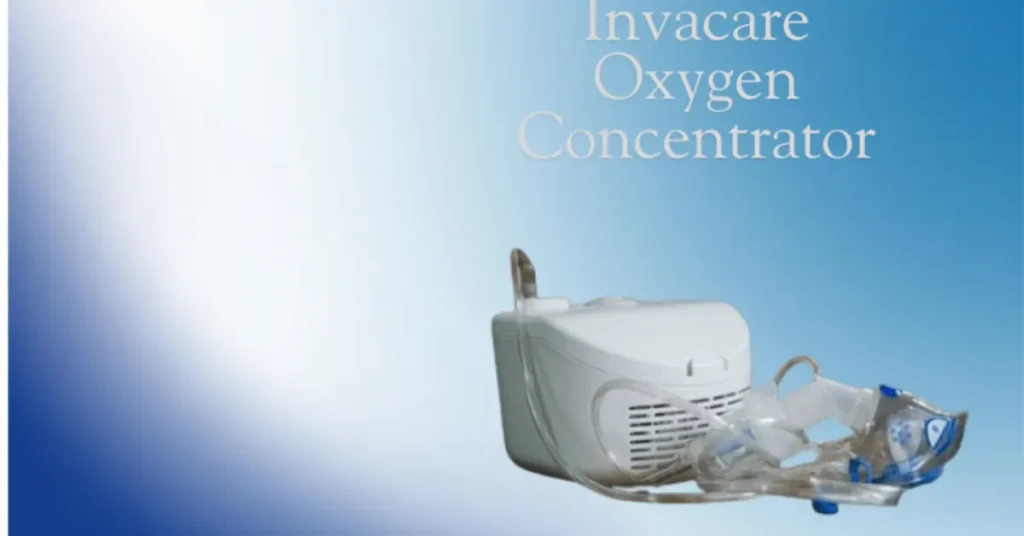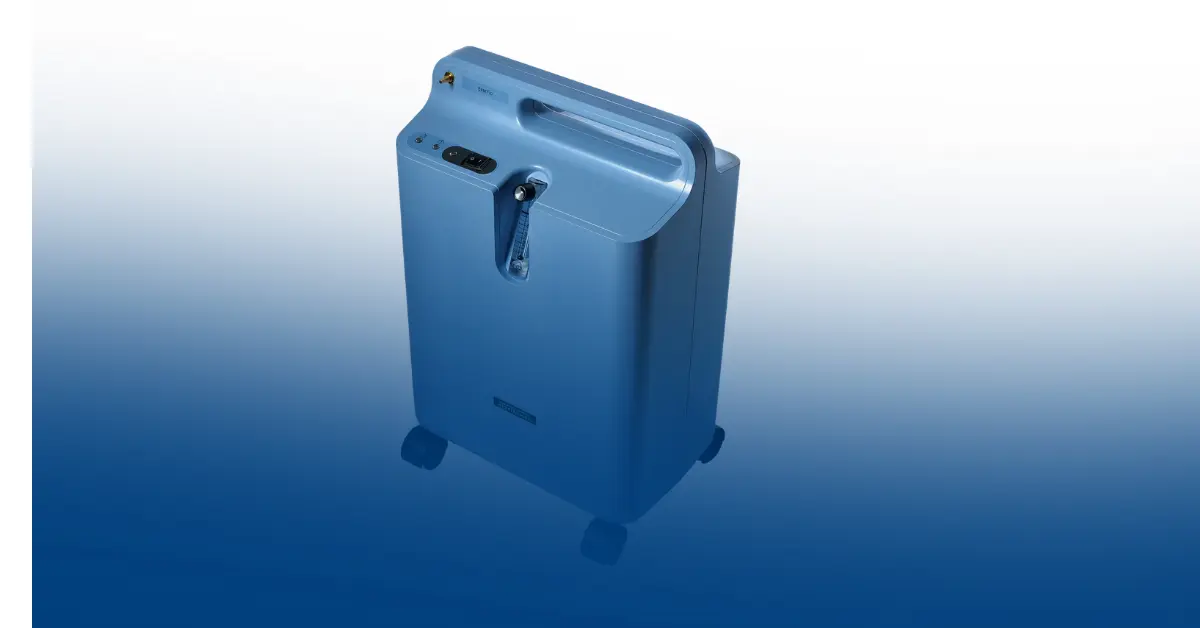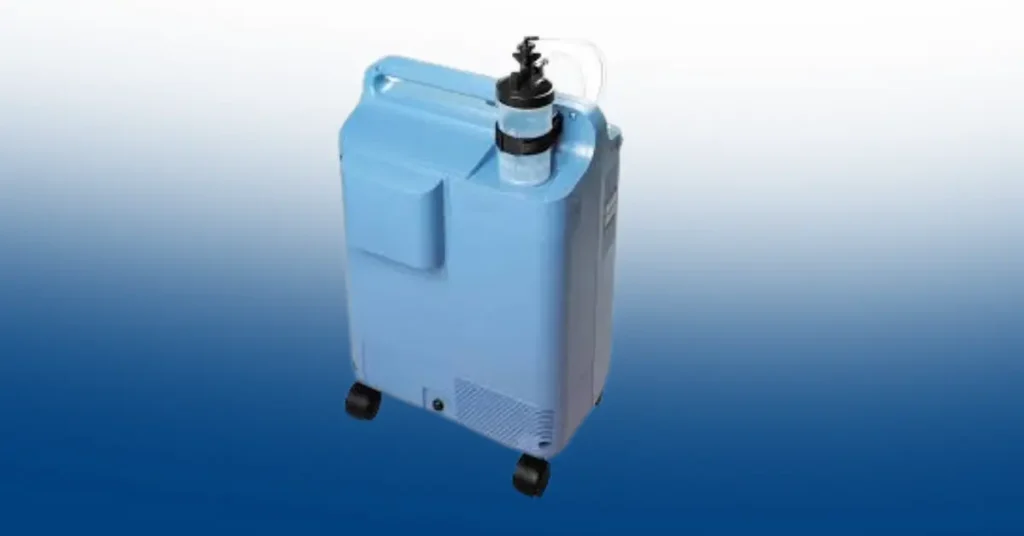Health
Invacare Oxygen Concentrator: Reliable Home Oxygen Solution

Table of Contents
Introduction
When it comes to home oxygen therapy, few names are as trusted as the Invacare Oxygen Concentrator. Designed with advanced technology and patient comfort in mind, Invacare has established itself as a global leader in respiratory care equipment. This article explores how Invacare’s devices deliver reliability, efficiency, and value for patients requiring continuous oxygen therapy.
What Is an Invacare Oxygen Concentrator?
An Invacare Oxygen Concentrator is a medical device that extracts oxygen from the surrounding air and delivers it to users with respiratory conditions like COPD, emphysema, or chronic bronchitis. Unlike oxygen tanks that require frequent refills, concentrators provide an endless oxygen supply as long as they remain plugged in.
Invacare’s models are engineered to offer quiet operation, energy efficiency, and enhanced mobility—making them a top choice for both home and clinical environments.
Key Features of Invacare Oxygen Concentrators
Invacare offers multiple models such as the Invacare Perfecto2 V and Invacare Platinum 10, each packed with innovative features. Some key highlights include:
- Continuous Flow Oxygen: Provides consistent oxygen output up to 10 liters per minute.
- Low Noise Operation: Advanced compressor design minimizes sound for peaceful home use.
- Energy Efficient: Uses minimal power, reducing electricity costs.
- Easy Maintenance: Designed for user-friendly filter replacement and cleaning.
- Built-In Alarms: Alerts for low oxygen purity, high temperature, or power issues.
Each feature of the Invacare Oxygen Concentrator aims to make long-term oxygen therapy safer and more comfortable.
How Does the Invacare Oxygen Concentrator Work?
The device works through Pressure Swing Adsorption (PSA) technology, separating nitrogen from ambient air and delivering oxygen-enriched air through a nasal cannula or mask. The Invacare Oxygen Concentrator continuously monitors oxygen purity to ensure optimal performance.
Here’s a simplified breakdown:
- Air Intake: The unit draws in surrounding air.
- Filtration: Removes dust and impurities.
- Oxygen Separation: Nitrogen is filtered out using zeolite sieve beds.
- Delivery: Pure oxygen is supplied to the user through tubing.
This self-sustaining system ensures patients receive high-purity oxygen without refilling tanks or cylinders.
Top Invacare Oxygen Concentrator Models
1. Invacare Perfecto2 V
- Compact, lightweight design
- Delivers up to 5 LPM (liters per minute)
- Energy Star rated for efficiency
- Ideal for home users needing moderate oxygen support
2. Invacare Platinum 10
- Heavy-duty concentrator with up to 10 LPM output
- Features top-grade filtration and durability
- Suitable for hospitals or patients requiring higher oxygen flow
Both models reflect Invacare’s commitment to combining medical-grade performance with user-friendly functionality.
Benefits of Using an Invacare Oxygen Concentrator
Using an Invacare Oxygen Concentrator offers several life-enhancing advantages:
- Reliable Oxygen Supply: Eliminates the need for cylinder refills.
- Cost-Effective: Reduces long-term expenses compared to oxygen tanks.
- Mobility Options: Compatible with portable oxygen devices.
- Enhanced Safety: Built-in sensors ensure purity and performance.
- Eco-Friendly: Uses air instead of disposable cylinders.
These benefits make Invacare devices a preferred choice among patients, caregivers, and healthcare professionals alike.
Maintenance and Safety Tips
To ensure your Invacare Oxygen Concentrator performs at its best:
- Clean or replace filters regularly (as per the manual).
- Keep the unit in a well-ventilated area.
- Avoid placing it near open flames or smoke.
- Check tubing for leaks or kinks.
- Schedule annual service by an authorized technician.
Routine care extends device lifespan and ensures uninterrupted oxygen therapy.
Where to Buy Invacare Oxygen Concentrators
You can purchase the Invacare Oxygen Concentrator through:
- Authorized dealers listed on the Invacare official website.
- Medical supply retailers such as Rehabmart and Vitality Medical.
- Healthcare providers who supply equipment through insurance programs.
Always verify the product authenticity and warranty when purchasing online or through third-party sellers.

Customer Reviews and Expert Insights
Patients praise the Invacare Oxygen Concentrator for its:
- Long lifespan
- Quiet operation
- Easy maintenance
- Reliable oxygen output
Respiratory therapists often recommend Invacare due to its stable performance and FDA-approved safety standards. These factors contribute to its reputation as a hospital-grade product trusted for home use.
Frequently Asked Questions (FAQs)
1. How long does an Invacare Oxygen Concentrator last?
Most models last between 5–7 years with proper maintenance and care.
2. Can I travel with an Invacare Oxygen Concentrator?
Yes. Invacare offers portable concentrators designed for travel, complete with rechargeable batteries.
3. How often should I service my concentrator?
It’s recommended to get the device professionally serviced once a year for optimal performance.
4. Does it work during power outages?
You’ll need a backup oxygen source or an uninterruptible power supply (UPS) to ensure continuous use.
5. Is it covered by insurance?
Many healthcare insurance plans cover Invacare Oxygen Concentrators when prescribed by a physician.
Conclusion
The Invacare Oxygen Concentrator stands out as a reliable, efficient, and medically certified oxygen therapy solution for patients needing consistent respiratory support. Whether you choose the Perfecto2 V for home use or the Platinum 10 for clinical settings, Invacare ensures superior performance, safety, and peace of mind.
By combining advanced technology with user comfort, the Invacare Oxygen Concentrator continues to redefine what home oxygen therapy can be — a seamless, secure, and life-improving experience.
Health
EverFlo Oxygen Concentrator: Efficient Home Oxygen System

Table of Contents
Introduction
The EverFlo Oxygen Concentrator has earned a strong reputation as one of the most efficient and user-friendly home oxygen therapy devices on the market. Manufactured by Philips Respironics, it’s designed to offer patients consistent oxygen flow while minimizing noise, energy consumption, and maintenance needs.
If you’re seeking a compact, dependable, and affordable oxygen solution, the EverFlo Oxygen Concentrator stands out for its simplicity and long-term reliability.
What Is the EverFlo Oxygen Concentrator?
The EverFlo Oxygen Concentrator is a stationary medical device that separates oxygen from ambient air and delivers high-purity oxygen to patients with respiratory conditions such as COPD (Chronic Obstructive Pulmonary Disease), asthma, or emphysema.
For a guide on nvacare Oxygen Concentrator click here
Unlike oxygen cylinders, it does not require refills. Instead, it extracts oxygen from the air continuously, providing an unlimited supply as long as it’s powered on. This makes the EverFlo model both cost-effective and low-maintenance for patients relying on home oxygen therapy.
Key Features of EverFlo Oxygen Concentrator
Philips designed the EverFlo Oxygen Concentrator to meet modern healthcare standards while keeping it simple and easy for home users. Here are its standout features:
- Compact and Lightweight: Weighs only 31 pounds, making it easy to move.
- Quiet Operation: Noise levels are below 45 decibels for peaceful sleep and comfort.
- Energy Efficient: Consumes only about 350 watts, reducing electricity costs.
- High Oxygen Purity: Provides 93% ±3% oxygen concentration for safe therapy.
- Durable Design: Long-life filters reduce the need for frequent servicing.
- Integrated Humidifier Bottle Holder: Adds comfort for patients needing moist oxygen.
Each feature of the EverFlo Oxygen Concentrator reflects Philips’ focus on comfort, reliability, and sustainability in home oxygen delivery.
How Does the EverFlo Oxygen Concentrator Work?
The EverFlo Oxygen Concentrator uses Pressure Swing Adsorption (PSA) technology to filter nitrogen and deliver purified oxygen. Here’s a simple explanation of the process:
- Air Intake: The device draws room air through its filter system.
- Filtration: Dust and particles are removed for cleaner air.
- Nitrogen Separation: Using zeolite sieve beds, nitrogen is separated from oxygen.
- Oxygen Delivery: Pure oxygen is delivered to the user through a nasal cannula.
The system ensures a steady supply of medical-grade oxygen without the need for cylinder replacements — one of the major advantages of the EverFlo Oxygen Concentrator.
Benefits of Using the EverFlo Oxygen Concentrator
Using the EverFlo Oxygen Concentrator comes with numerous benefits that enhance both patient comfort and quality of life:
- Low Maintenance: No filter changes for up to two years.
- Reduced Operating Costs: Energy-efficient design saves on monthly bills.
- Portable for Home Use: Easy to move from one room to another.
- Quiet Functioning: Ideal for use during sleep or while watching TV.
- Environmentally Friendly: No cylinder refills or transport emissions.
These advantages make the EverFlo Oxygen Concentrator a preferred choice for patients who value convenience and reliability in long-term oxygen therapy.
EverFlo vs. Other Oxygen Concentrators
When compared to other home oxygen systems, the EverFlo Oxygen Concentrator has several competitive advantages:
| Feature | EverFlo | Invacare | AirSep VisionAire |
|---|---|---|---|
| Weight | 31 lbs | 43 lbs | 30 lbs |
| Power Consumption | 350W | 410W | 290W |
| Noise Level | <45 dB | 50 dB | 45 dB |
| Maintenance | Low | Moderate | Moderate |
| Warranty | 3 years | 3 years | 2 years |
This comparison highlights that the EverFlo Oxygen Concentrator provides an excellent balance of lightweight design, efficiency, and quiet operation, making it ideal for most home-based patients.
Maintenance and Safety Tips
To ensure long-term performance, users should follow these maintenance and safety tips for their EverFlo Oxygen Concentrator:
- Keep the device away from walls to maintain airflow.
- Replace or clean filters as recommended.
- Avoid smoking or open flames near the unit.
- Use distilled water in the humidifier bottle.
- Schedule professional service every 12 months.
Routine maintenance not only extends the device lifespan but also guarantees consistent oxygen purity and safe operation.

Where to Buy the EverFlo Oxygen Concentrator
You can purchase the EverFlo Oxygen Concentrator through several trusted medical suppliers and online platforms such as:
- Philips Respironics Authorized Dealers
- RehabMart
- Vitality Medical
- Medical Supply Depot
- Amazon (with verified medical sellers)
Always ensure you’re buying from a certified dealer to receive warranty support and genuine parts.
Customer Reviews and Expert Insights
Healthcare professionals praise the EverFlo Oxygen Concentrator for its reliability, simplicity, and minimal upkeep. Patients often highlight its:
- Low noise output
- Compact design
- Energy savings
- Continuous oxygen flow
Experts also note that Philips’ use of long-lasting filters and durable internal components contributes to fewer breakdowns, which is especially valuable for patients needing 24-hour oxygen therapy.
Technical Specifications
| Specification | Details |
|---|---|
| Oxygen Flow | Up to 5 LPM |
| Oxygen Concentration | 93% ±3% |
| Power Consumption | 350W |
| Sound Level | ≤45 dB |
| Weight | 14 kg (31 lbs) |
| Dimensions | 23” H x 15” W x 9.5” D |
| Warranty | 3 years |
These specifications show why the EverFlo Oxygen Concentrator is among the most efficient and quiet oxygen systems for residential use.
Frequently Asked Questions (FAQs)
1. How long can I run the EverFlo Oxygen Concentrator?
The EverFlo Oxygen Concentrator is designed for continuous use and can operate 24/7 with proper ventilation.
2. Does it require distilled water?
Yes, if using the humidifier attachment, always fill it with distilled water to avoid mineral buildup.
3. Is it noisy?
No, it operates below 45 decibels—quieter than most home concentrators.
4. How often should I service it?
It requires professional service once a year or as recommended by Philips.
5. Can I travel with this device?
The EverFlo Oxygen Concentrator is a stationary model, not portable, but easy to move around your home.
Conclusion
The EverFlo Oxygen Concentrator by Philips Respironics represents a perfect blend of performance, reliability, and user comfort. Its low maintenance design, quiet operation, and energy efficiency make it one of the best home oxygen therapy systems available today.
For patients who need continuous oxygen support without constant cylinder replacements, the EverFlo Oxygen Concentrator is a dependable, cost-effective, and long-lasting solution.
Health
Transforming Mental Health: TMS Treatment APN for Lasting Recovery

Introduction
TMS Treatment APN is reshaping the way people approach mental health recovery. Short for Transcranial Magnetic Stimulation administered by Advanced Practice Nurses (APNs), this treatment provides a safe, drug-free option for individuals struggling with conditions like depression, anxiety, and other mental health disorders. Unlike traditional therapies that may rely heavily on medication, TMS Treatment APN uses magnetic pulses to stimulate brain activity, offering hope to those who haven’t found relief through standard approaches.
In this article, we’ll break down what TMS Treatment APN is, how it works, its benefits, risks, effectiveness, and what you should know before considering it as a treatment option.
1. What Is TMS Treatment APN?
TMS Treatment APN refers to Transcranial Magnetic Stimulation therapy delivered under the care of Advanced Practice Nurses (APNs). It’s a non-invasive, FDA-cleared therapy that targets specific areas of the brain responsible for mood regulation.
APNs play a critical role in modern mental health care by providing patient-centered, evidence-based treatment. When combined with TMS, their expertise ensures not only technical precision but also personalized support.
More Article Here
2. How Does TMS Treatment APN Work?
TMS involves placing a magnetic coil near the patient’s scalp. This device delivers gentle magnetic pulses that stimulate underactive brain cells, encouraging healthier neural activity. Over time, this process helps regulate mood and reduce symptoms of depression or anxiety.
Sessions typically last between 20 to 40 minutes, and patients can resume daily activities immediately afterward.
3. Conditions Treated with TMS
While TMS is best known for treating depression, research shows it may also help with:
-
Anxiety disorders
-
Post-traumatic stress disorder (PTSD)
-
Obsessive-compulsive disorder (OCD)
-
Chronic pain conditions
-
Bipolar depression (in certain cases)
4. Why Choose APN-led TMS Treatment?
APNs bring advanced clinical training, holistic care, and personalized monitoring to TMS therapy. Their approach balances medical science with compassionate support, creating a safe and patient-friendly environment.
5. Benefits of TMS Treatment APN
-
Non-invasive: No surgery or anesthesia required.
-
Drug-free: Ideal for patients who don’t tolerate medication side effects.
-
Minimal downtime: Patients can continue normal activities right after sessions.
-
Proven effectiveness: Especially for treatment-resistant depression.
-
Personalized care: Tailored by skilled APNs to meet individual needs.
6. Comparison: TMS vs. Traditional Therapies
| Feature | TMS Treatment APN | Traditional Therapies (Medication/Talk Therapy) |
|---|---|---|
| Invasiveness | Non-invasive | Medication side effects or invasive treatments |
| Effectiveness in Resistant Cases | High | Often limited |
| Side Effects | Mild headaches, scalp discomfort | Weight gain, fatigue, dependency |
| Recovery Time | Immediate return to activities | Adjustment period required |
| Personalization | Tailored by APNs | Varies by provider |
7. Who Is a Candidate for TMS Treatment APN?
TMS is suitable for adults who:
-
Struggle with major depressive disorder or anxiety
-
Have not responded well to medication or therapy
-
Prefer a drug-free approach
-
Are medically cleared for non-invasive brain stimulation
8. Treatment Process: Step-by-Step
-
Initial Consultation: APN reviews medical and psychiatric history.
-
Mapping Session: Coil placement is adjusted for targeted stimulation.
-
Treatment Sessions: Daily sessions over 4–6 weeks.
-
Monitoring Progress: APN evaluates improvements and adjusts treatment.
-
Maintenance (if needed): Follow-up sessions to sustain results.
9. Possible Side Effects and Risks
Most patients tolerate TMS well, but mild side effects can include:
-
Headaches
-
Scalp discomfort
-
Tingling sensations
-
Temporary dizziness
Serious risks are extremely rare, making TMS safer than many other interventions.
10. How Long Do Results Last?
Many patients experience long-term relief after completing a treatment course. While some may need booster sessions, improvements often last months or even years, depending on individual response.
11. Cost and Accessibility of TMS Treatment APN
The cost varies depending on location, provider expertise, and insurance coverage. While it can be more expensive upfront than medication, its long-term effectiveness often reduces overall healthcare expenses.
12. Role of APNs in Mental Health Innovation
Advanced Practice Nurses bridge the gap between medical expertise and personalized care. By leading TMS treatment, they ensure patients receive safe, compassionate, and innovative support throughout their healing journey.
13. Patient Experiences and Outcomes
Patients often report:
-
Noticeable mood improvements
-
Enhanced focus and productivity
-
Better sleep patterns
-
Renewed motivation and energy
14. Common Myths About TMS Treatment APN
-
Myth: TMS is painful.
Fact: The pulses cause mild tapping sensations, not pain. -
Myth: TMS causes memory loss.
Fact: Unlike ECT, TMS does not impair memory. -
Myth: Only psychiatrists can perform TMS.
Fact: Skilled APNs are fully qualified to deliver TMS therapy safely.
15. Future of TMS in Mental Health Care
With ongoing research, TMS is expected to expand into treatments for dementia, stroke recovery, and even addiction. The combination of APN-led care and advanced technology will continue to transform mental health outcomes.
16. FAQs
Q1. Is TMS Treatment APN safe?
Yes, it is FDA-cleared, non-invasive, and has minimal side effects.
Q2. How many sessions are needed?
Typically, 20–30 sessions over 4–6 weeks are required.
Q3. Can TMS replace medication?
For some patients, yes. Others may still combine it with medication for optimal results.
Q4. Does insurance cover TMS Treatment APN?
Coverage varies, but many providers now include TMS in mental health benefits.
Q5. How soon can I expect results?
Some patients notice improvements within 2 weeks, while others take longer.
Conclusion
TMS Treatment APN is a groundbreaking approach to mental health recovery. By combining advanced brain stimulation technology with the expertise of Advanced Practice Nurses, patients gain access to safe, effective, and personalized care. Whether you’re seeking relief from depression, anxiety, or other mental health challenges, TMS Treatment APN offers a promising path toward long-term well-being and resilience.
Fashion
Transform Your Clean Routine with “Sanitation Towels”: Why They’re a Game-Changer

Keeping our surroundings clean and ourselves healthy remains a top priority. But traditional cleaning tools often fall short on sustainability, cost-efficiency, or sheer effectiveness. Enter Sanitation Towels—a versatile, increasingly popular solution that blends hygiene, convenience, and environmental sense. This article dives deep into what they are, how they work, their benefits, comparisons with other options, usage tips, and answers to common questions.
What Are Sanitation Towels?
“Sanitation Towels” refers to towels or cloths designed specifically for maintaining hygiene. They can be manufactured in reusable forms (like cotton, microfiber, bamboo, or blended fibers) or disposable formats (nonwoven materials). The key traits are:
-
Strong absorbency
-
Ability to trap or remove germs, dirt, moisture
-
Durability (in reusable versions)
-
Safe for skin and varied surfaces
These towels are used in homes, healthcare settings, travel, commercial environments, and even in menstrual hygiene (when the term overlaps with sanitary/pad usage in certain contexts), depending on regional needs and definitions.
More Article Here
Why Sanitation Towels Matter: Key Benefits
Let’s break down why they are increasingly seen as a smart investment for health and everyday life.
| Benefit | What It Means for You |
|---|---|
| Enhanced Hygiene | They reduce cross-contamination as many reusable versions can be washed frequently; disposable ones provide single-use sanitation. |
| Cost Savings Over Time | Reusable towels, though more costly upfront, reduce recurring spending compared to paper towels or disposable wipes. |
| Environmental Impact | Less waste, fewer resources (water, energy) used if reusables are cared for correctly. Biodegradable materials further reduce ecological footprint. |
| Versatility | Safe on multiple surfaces—countertops, sinks, wood, stainless steel, skin—when material and care are appropriate. |
| Convenience & Portability | Compact reusable towels can be carried, cleaned, and stored easily; disposable ones are handy in public or travel settings. |
| Comfort and Health | Softer materials, less chemical residue, fewer irritations for sensitive skin if the towel is clean and made of high-quality fibers. |
How Sanitation Towels Compare: A Chart
To help you choose, here’s a practical comparison among Reusable Sanitation Towels, Disposable Sanitation Towels, and Traditional Cloth Towels:
| Feature | Reusable Sanitation Towel | Disposable Sanitation Towel | Traditional Cloth Towel |
|---|---|---|---|
| Hygiene Level | High, when washed properly and dried fully | Very high for single-use (no reuse) | Moderate; risk if damp or infrequently cleaned |
| Cost Over Time | Moderate-high upfront cost; low per use | Low upfront; higher ongoing cost if always buying | Low initial; costs in washing, replacement over time |
| Environmental Impact | Better if washed with care; lower waste | Generates waste; depends on material (biodegradability) | Similar to reusable; but often thicker and may need more resources to clean/dry |
| Durability | Excellent with good quality material | Single use or short lifespan | Variable; high-quality ones last long but degrade with heavy use |
| Convenience | Need to wash, dry, store; needs care | Extremely convenient; easy disposal | Requires laundry; may retain odors or microbes if not cleaned well |
| Skin & Surface Safety | Materials without harsh chemicals; gentle if clean | Sometimes treated; risk of irritants in low-quality disposables | Generally safe, but risk if fabric is coarse or not clean |
Best Practices: Using Sanitation Towels Correctly
To get maximum benefit, follow these guidelines:
-
Choose the Right Material:
For skin or delicate surfaces, opt for soft natural fibers or microfiber blends. For heavy-duty cleaning, slightly coarser weaves or more absorbent types work better. -
Maintain Cleanliness:
Wash reusable towels after use, using hot water (as appropriate for the material) to kill germs. Avoid leaving them damp in enclosed spaces. Dry fully before storing. -
Designate Towels by Purpose:
Have separate towels for bathrooms, kitchens, face/skin, and general cleaning to prevent bacteria transfer. -
Sanitize Periodically:
Use mild disinfectants or natural sanitizers (like vinegar or baking soda solutions) where necessary. Simplify but don’t skip. -
Dispose Responsibly:
If using disposable versions, opt for biodegradable ones and dispose of them properly to avoid environmental damage. -
Inspect Regularly:
Reusable towels degrade with time: thinning, loose threads, unpleasant odor. Replace when they no longer clean effectively or begin deteriorating.
Real-World Applications: Where Sanitation Towels Shine
-
Healthcare & Clinics: Single-use or sterilizable reusable towels help in preventing hospital-acquired infections.
-
Kitchens & Food Prep Areas: Frequent wiping and changing to prevent cross-contamination.
-
Public Spaces & Travel: Disposable packs handy where laundry or cleaning facilities aren’t available.
-
Home Routine: Daily spill cleanups, personal hygiene, caring for children or pets.
-
Menstrual Hygiene Contexts: In places where reusable pads or cloths are used under practices with good washing and drying, sanitation towels become part of menstrual care.
Risks & Limitations
While very useful, sanitation towels are not magic. Consider the following:
-
If reusable towels are not washed or dried properly, they can become breeding grounds for microbes.
-
Disposables may contain chemicals or dyes that can irritate sensitive skin if low quality.
-
Environmentally, manufacturing, washing, and laundering processes also have resource costs (water, energy, detergent).
-
Upfront cost of high-quality reusable towels can deter some users.
Trends & What’s New
-
Increasing demand for biodegradable disposables and plant-based fibers in reusable towels.
-
Innovations in antimicrobial finishes that resist odor and bacterial growth (without harsh chemicals).
-
Consumer awareness growing in many countries about life-cycle impact: cost + environmental + health combined.
-
Public health programs in low-income areas increasingly include guidance for reusable menstrual materials under sanitation towel concepts.
5 FAQs Before Conclusion
-
Are sanitation towels safe for sensitive skin?
Yes—if made from hypoallergenic materials and kept clean. Always test on a small area first, especially for facial or skin use. -
How often should reusable sanitation towels be washed?
After every heavy use or spill. For general wiping tasks, washing every day or every other day is optimal; ensure full drying between uses. -
Can disposable sanitation towels cause environmental harm?
They can—if not biodegradable or if overused. Choose options made from biodegradable fibers or compostable materials. -
Do high-quality reusable towels cost more upfront?
Yes. But over time, the cost per use drops significantly, often making them more economical in the long run. -
How do I store sanitation towels to avoid odors or mold?
Store them completely dry, in a clean, ventilated space. Avoid piling wet towels. Wash storage areas occasionally.
Conclusion
Sanitation Towels blend hygiene, sustainability, and usability. Whether you choose reusable or disposable forms—or even a mix depending on setting—they offer a powerful way to maintain health, reduce waste, and manage costs. By selecting the right materials, caring for them properly, and recognizing their appropriate use-cases, you can transform your cleaning and hygiene routines for the better. Embrace the change: cleaner spaces, healthier habits, smarter living.
-

 Must Read5 months ago
Must Read5 months agoThe Truth Behind the Direct Fairways Lawsuit: What You Need to Know
-

 Business5 months ago
Business5 months agoTop Chartered Accountants Benefits: Guide, Tips, FAQs & More
-

 Tech5 months ago
Tech5 months agoblogsternation .com: Complete Beginner’s Guide, Benefits, and FAQs
-

 Tech4 months ago
Tech4 months agoHow to Upgrade Graphics Driver: Boost Speed, Fix Issues & Enhance Gaming
-

 Sports5 months ago
Sports5 months agoHow Many Quarters in Football? A Complete Guide to Game Structure and Timing
-

 Education5 months ago
Education5 months agoOxford Acceptance Rate: What It Means, Why It Matters, and How to Beat It
-

 Business5 months ago
Business5 months agoUnlocking the Truth About gomyfinance.com Credit Score
-

 Must Read5 months ago
Must Read5 months agoEscalade Must Have Accessories for the Ultimate Cadillac Experience



















